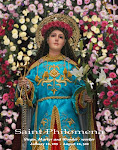Praised be Jesus, Mary, and
Joseph!
“The people who sit in darkness
have seen a great light.”
It is quite significant that the Lord
begins his preaching in the borders of Zabulon and Nephtali, the Galilee of the gentiles. [There were two Galilees; one of
the Jews and the other of the Gentiles. This division of Galilee had existed
from Solomon’s time, who gave 20 cities in Galilee to Hyram, King of Tyre; this
part was afterwards called Galilee of the Gentiles; while the remainder was
called the Galilee of the Jews. Zabulon and
Nephtali were two tribes that were taken captive by the Assyrians.] It was the
Gentiles that the prophet Isaiah referred to as the people which sat in
darkness. The Gentiles sat in darkness because they did not know the true God.
They worshipped idols and demons and so they lived in the region of death. St.
John Chrysostom said “they (gentiles) found it (light) not of their own
seeking, but God Himself appeared to them…for men were in the greatest miseries
before Christ’s coming; they did not walk but sat in darkness, which was a sign
that they hoped for deliverance; for as not knowing what way they should go,
shut in by darkness, they sat down having no power to stand. By darkness he means
here, error and ungodliness.”
 |
| The Light of Christ draws us out of darkness |
Darkness is debilitating. When we
are covered with thick darkness, there is nothing much we can do. If this is
true with physical light, it is even truer with spiritual light. “Darkness
means error and ungodliness.” Therefore, ignorance of the true God is
debilitating. One who is shut in by darkness does not know where to go. He
loses the right sense of direction. He simply goes round and round until
finally, in exhaustion, he sits in the dark as he hopes that light will soon
find him. Many people falsely think that they can go through life without the
light of religion. But Pope Francis himself says: “faith is a light, for once
the flame of faith dies out, all other lights begin to dim. The light of faith is unique, since it is
capable of illuminating every
aspect of human existence. A
light this powerful cannot come from ourselves but from a more primordial
source: in a word, it must come from God. Faith is born of an encounter with
the living God who calls us and reveals his love, a love which precedes us and
upon which we can lean for security and for building our lives. Transformed by
this love, we gain fresh vision, new eyes to see; we realize that it contains a
great promise of fulfilment, and that a vision of the future opens up before
us. Faith, received from God as a supernatural gift, becomes a light for our
way, guiding our journey through time.” [Lumen Fidei, 4.]
Christ is the
Light that enlightens every man. As the magi, after having encountered Christ,
went home using a different road, one who encounters Christ cannot help but be
changed by this encounter. As Christ illuminates every aspect of our human
existence, we begin to see reality in a new perspective – which is definitely
wider than the constricting point of view of our flesh. Christ, who enlightens
us, calls out to us: “Repent, for the kingdom of heaven is at hand.” After
discovering that Christ offers us something better than the world can give,
turning our back to the world is the only reasonable response. Why insist on
what is limited when what is better is standing before us? Why insist on
sitting in darkness when the inviting light of Christ is calling us to him? At
the end of a black out, our instinct is to clap our hands in joy at the lifting
of darkness and the coming of light. Christ our light shines on us and he has
brought us “abundant joy and great rejoicing” for he has smashed the yoke of
sin which burdened us and has shattered the rod of the devil who oppressed us.
Jesus, I trust in
you. O Mary conceived without sin, pray for us who have recourse to thee.














